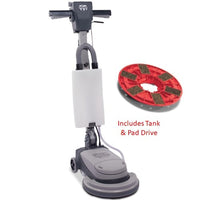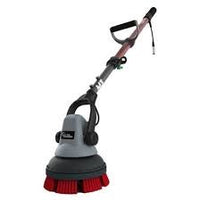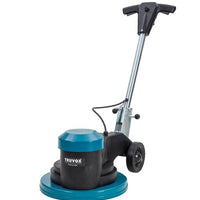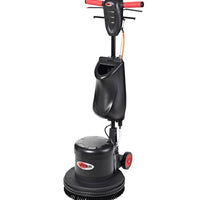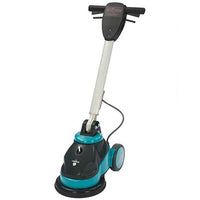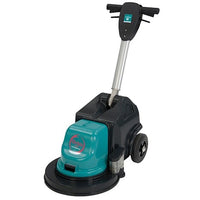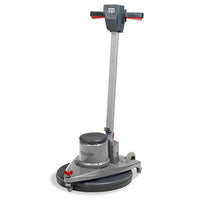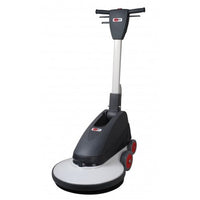Collection: Rotary Floor Cleaning Machines
Comprehensive range of professional rotary floor polishing machines for complete floor care. From compact single disc scrubbers for daily maintenance to heavy-duty stripping machines, our selection delivers superior results across all floor types, ensuring professional standards and extended floor life.
Complete the demonstration form here and we can arrange a suitable date time to show you your next cleaning machine.




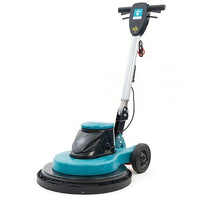




Rotary Floor Polishing Machines Product information
At ClickCleaning, we understand that maintaining pristine floor appearance requires more than basic cleaning - it demands professional equipment designed for specific floor care tasks. Our rotary floor machine range encompasses everything from versatile single disc machines for daily maintenance to specialised high-speed burnishers that create mirror-like finishes on polished floors.
Rotary floor machines, often called buffers or single disc machines, remain the workhorses of professional floor care. These versatile machines tackle multiple tasks through interchangeable pads and brushes - from aggressive stripping of old polish through deep scrubbing to high-speed polishing. Understanding the capabilities and selecting appropriate machines transforms floor maintenance from labour-intensive drudgery into efficient, professional operations.
Our standard-speed rotary machines operating at 150-200 rpm excel at general cleaning, scrubbing, and stripping applications. These foundational machines provide the controlled power necessary for removing old floor finishes, deep cleaning heavily soiled floors, and preparing surfaces for new coatings. The moderate speed delivers optimal pad contact time, ensuring thorough cleaning without excessive heat generation that might damage sensitive floors.
High-speed machines running at 300-500 rpm bridge the gap between cleaning and polishing, offering versatility for facilities requiring both capabilities. These dual-purpose machines scrub effectively with appropriate pads whilst also achieving good polishing results, making them popular choices for facilities seeking single-machine solutions. The increased speed improves productivity whilst maintaining sufficient control for detailed work.
Ultra high-speed burnishers operating at 1000-3000 rpm specialise in creating brilliant shine on properly prepared floors. These machines generate the heat and pressure necessary to compress floor finish into mirror-like surfaces, though they require skilled operation and appropriate floor finishes. Our burnisher range includes both electric and battery-powered options, enabling shine restoration even in areas without convenient power access.
Machine weight significantly influences performance and application suitability. Lighter machines around 20-30 kg prove easier to manoeuvre and transport between areas but may lack the down-pressure necessary for aggressive stripping. Heavier machines from 40-70 kg provide superior stripping performance and stability but demand greater operator strength and may require lift access between floors. We help customers balance performance requirements with practical handling considerations.
Power options extend beyond traditional mains-powered models. Battery-powered machines eliminate trailing cables that create trip hazards and restrict movement, proving invaluable for daytime cleaning in occupied spaces. Modern battery technology delivers runtime exceeding 2 hours whilst maintaining consistent power output. Propane burnishers offer unlimited runtime for large facilities, though they require adequate ventilation and specialised handling procedures.
Pad drive systems deserve careful consideration as they directly impact machine versatility and pad security. Traditional centre-lock systems provide secure pad attachment for aggressive applications but require specific pad types. Pad holder systems accept any standard floor pad, offering maximum flexibility for facilities using various pad types. Some machines feature quick-change systems that minimise downtime between different floor care tasks.
Handle design affects operator comfort and machine control significantly. Adjustable handles accommodate different operator heights, reducing fatigue during extended use. Safety switches requiring two-handed operation prevent accidental starts, whilst variable speed controls enable optimisation for different tasks. Ergonomic grips and vibration reduction features improve operator comfort during long shifts.
Tank systems on solution-equipped machines enable wet scrubbing without buckets and mops. These machines apply cleaning solution directly to floors whilst scrubbing, improving cleaning effectiveness and reducing labour. Tank capacities range from 10-40 litres, with larger tanks extending operational time between refills. Solution control systems prevent over-wetting that might damage water-sensitive floors.
Dust control features on high-speed machines capture airborne particles generated during dry burnishing. Active vacuum systems with HEPA filtration protect indoor air quality whilst reducing post-cleaning dust settlement. These features prove essential in healthcare facilities and other environments where air quality matters.
Whether maintaining retail showrooms, restoring industrial floors, or ensuring healthcare facilities meet the highest standards, our rotary floor machine range provides the power, versatility, and reliability professional floor care demands. Our team's extensive experience helps customers select optimal machines for their specific floor types and maintenance requirements, ensuring successful floor care programmes that protect investments and maintain professional appearances.
Rotary Floor Polishing Machines FAQs
What's the difference between low-speed and high-speed rotary machines?
Speed fundamentally determines machine application and capabilities. Low-speed machines (150-200 rpm) excel at wet scrubbing, stripping, and deep cleaning through extended pad contact time. The slower rotation allows cleaning solutions to work effectively whilst providing controlled aggressive action for stubborn soils and old finish removal.
High-speed machines (1000-3000 rpm) specialise in polishing and burnishing, generating heat through friction that compresses floor finish into brilliant shine. These machines require specific technique and appropriate floor finishes - attempting to strip or scrub at high speed proves ineffective and potentially damaging.
Medium-speed machines (300-500 rpm) offer versatility, handling both cleaning and polishing tasks reasonably well. While not matching specialists at either extreme, they provide practical solutions for facilities needing both capabilities from single machines. Consider your primary applications when selecting speeds.
What size rotary machine should I choose?
Machine size typically refers to pad diameter, ranging from 13" to 20" for most applications. Smaller 13-15" machines prove highly manoeuvrable, ideal for congested areas, edges, and facilities with numerous obstacles. These compact units suit small retail spaces, offices, and anywhere detailed work matters more than raw coverage.
Standard 17" machines balance productivity with manoeuvrability effectively, representing the most popular size for general commercial use. They cover ground efficiently whilst remaining manageable for most operators. This size handles everything from small shops to large retail spaces effectively.
Larger 19-20" machines maximise productivity in open areas but sacrifice agility. These machines suit warehouses, large retail floors, and facilities where coverage speed outweighs manoeuvrability requirements. Consider operator capability, as larger machines require more strength to control effectively.
How do I choose the right floor pads?
Floor pad selection dramatically impacts results and floor safety. Pads are colour-coded by aggressiveness: black pads
strip finishes aggressively, green pads scrub heavily soiled floors, red pads clean moderately, white pads polish gently, and specialist pads serve specific purposes.
Match pad aggression to tasks carefully - using stripping pads for routine cleaning damages floors unnecessarily. Conversely, attempting to strip with polishing pads wastes time and effort. We stock complete pad ranges and advise on optimal selection for specific applications.
Natural fibre pads like hog hair excel at polishing stone floors, whilst synthetic pads suit most commercial flooring. Diamond-impregnated pads restore stone floors without chemicals, though initial investment is higher. Consider purchasing multiple pad types for comprehensive floor care capability.
Can rotary machines be used on all floor types?
While rotary machines demonstrate impressive versatility, appropriate selection and technique prove crucial for floor safety. Vinyl, linoleum, and sealed concrete handle all rotary machine applications well, from aggressive stripping through gentle polishing. These resilient surfaces form commercial flooring's backbone precisely because they tolerate varied maintenance approaches.
Natural stone requires careful consideration - soft stones like marble scratch easily with aggressive pads, whilst granite tolerates more aggressive treatment. Always use appropriate pads and chemicals for stone types. Wooden floors generally prove unsuitable for wet rotary cleaning unless specifically sealed for such treatment.
Ceramic tiles clean well with rotary machines, though grout lines may require cylindrical brush machines for thorough cleaning. Safety flooring with raised profiles needs special brushes rather than pads. Always test in inconspicuous areas when uncertain about compatibility.
What's the difference between brush and pad operation?
Brushes and pads serve distinctly different purposes on rotary machines. Pads provide consistent surface contact ideal for stripping, cleaning, and polishing smooth floors. The uniform pressure distribution prevents gouging whilst delivering predictable results. Pads require smooth surfaces for effective operation.
Brushes excel on textured surfaces where pads cannot maintain contact. Stiff brushes penetrate grout lines, safety floor profiles, and irregular surfaces that defeat pads. Soft brushes gently clean delicate surfaces or work cleaning solutions into textured floors without aggressive mechanical action.
Many machines accept both brushes and pads, providing maximum versatility. Quick-change systems enable rapid switching between attachments for different areas or tasks. Consider your floor types when deciding whether brush capability matters for your application.
How much do rotary machines weigh and why does it matter?
Machine weight directly impacts both performance and handling. Lighter machines (20-30 kg) prove easier to transport and manoeuvre, reducing operator fatigue during extended use. They're ideal for multi-floor facilities or where frequent movement between areas is required.
Heavier machines (40-70 kg) provide superior down-pressure for aggressive stripping and more stable operation at high speeds. The additional weight improves pad contact and prevents machine walking during operation. However, they demand greater operator strength and may require mechanical handling.
Some machines feature removable weights, allowing adjustment for different tasks. This versatility enables gentle cleaning with weights removed or aggressive stripping with full weight applied. Balance performance requirements against operator capabilities and facility logistics when selecting machine weight.
What safety features should I look for?
Modern rotary machines incorporate numerous safety features protecting operators and bystanders. Dead-man switches requiring continuous grip prevent runaway machines if operators lose control. These critical safety features should never be bypassed or modified.
Electrical safety includes double insulation, circuit breakers, and hospital-grade plugs preventing shock hazards. Cable management systems keep cords clear of moving parts whilst strain reliefs prevent connection damage. Battery-powered machines eliminate most electrical hazards.
Mechanical safety features include splash guards containing spray from wet operations, non-marking bumpers protecting walls and furniture, and warning labels identifying hazards. Ergonomic handles reduce strain injuries whilst proper balance prevents tipping. Prioritise machines with comprehensive safety features for operator protection.
What maintenance do rotary machines require?
Regular maintenance ensures reliable performance and extends machine life significantly. Daily tasks include cleaning pad drivers of accumulated finish and debris, checking cables for damage, and wiping down machines to prevent buildup. These simple steps prevent most common problems.
Weekly maintenance involves checking carbon brushes on motors, inspecting pad drivers for wear, and lubricating specified points. Worn carbon brushes cause motor damage if ignored, whilst damaged pad drivers create dangerous projectiles. Follow manufacturer specifications for lubrication types and frequencies.
Professional annual servicing addresses motor bearings, gear cases, and electrical systems beyond routine maintenance scope. This preventive maintenance identifies developing issues before failure, proving far more economical than emergency repairs. Document all maintenance for warranty compliance.
Are battery-powered rotary machines worth the investment?
Battery machines typically cost 40-60% more than mains-powered equivalents but offer compelling advantages. Eliminating trailing cables removes trip hazards, enables daytime cleaning in occupied spaces, and provides unlimited mobility. Modern batteries deliver 2-3 hours runtime, sufficient for most applications.
Productivity gains often justify premium pricing. Operators work faster without cable management, access areas far from power points, and clean without disrupting business operations. Calculate labour savings from improved efficiency when evaluating battery machine value.
Battery replacement costs require consideration - lead-acid batteries last 2-3 years at £200-400, whilst lithium batteries cost £800-1500 but last 5-7 years. Factor total ownership costs including batteries when comparing options. Many facilities find battery machines essential once experienced.
What's the typical lifespan of a rotary floor machine?
Quality rotary machines deliver 10-15 years of reliable service with proper maintenance. Professional-grade machines feature robust motors, heavy-duty gearboxes, and replaceable components that extend service life significantly compared to budget alternatives lasting perhaps 3-5 years.
Usage intensity affects lifespan considerably - machines used daily wear faster than those used weekly. However, regular use often correlates with better maintenance, as operators notice developing issues promptly. Neglected machines fail prematurely regardless of build quality.
Component replacement extends machine life economically. Motors, gearboxes, and handles can be replaced at fraction of new machine cost. We stock parts for all our machines, supporting long-term maintenance programmes that maximise equipment investments. Consider long-term support availability when selecting machines.


